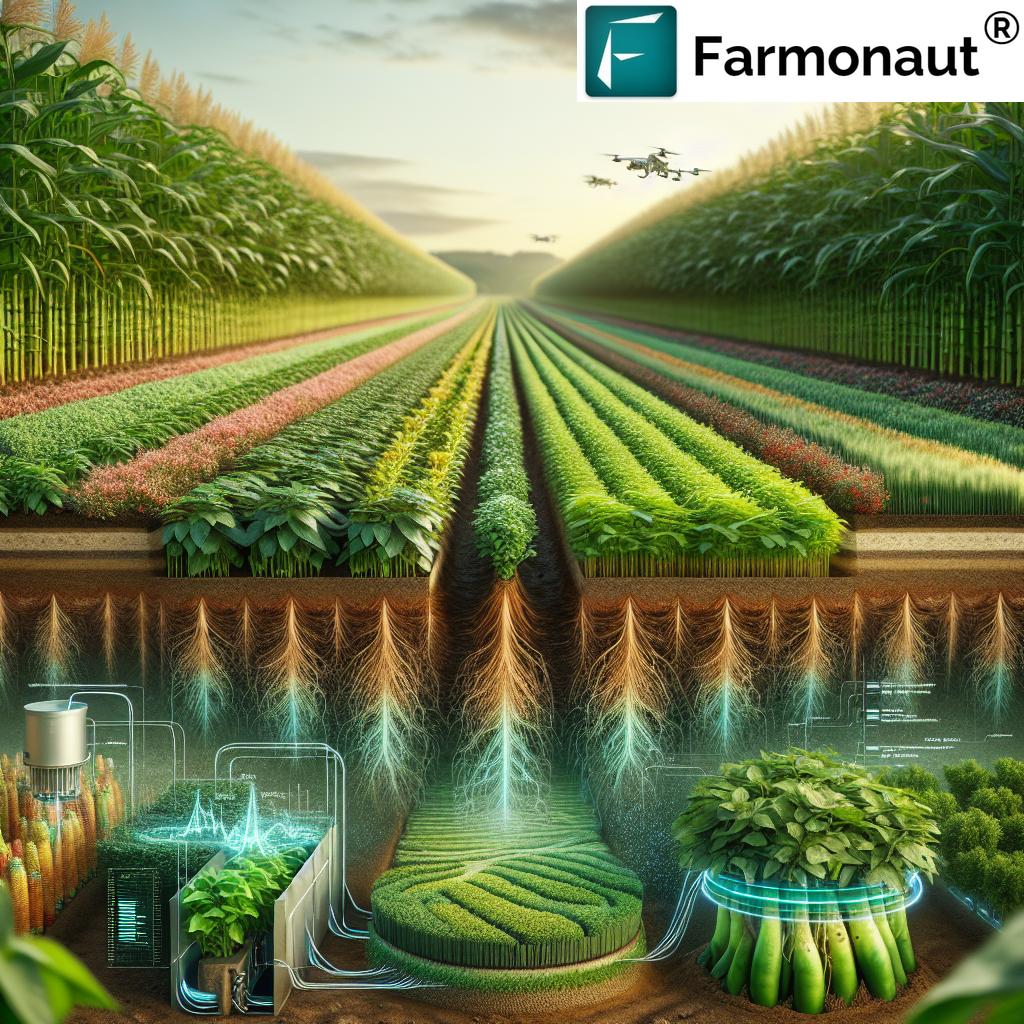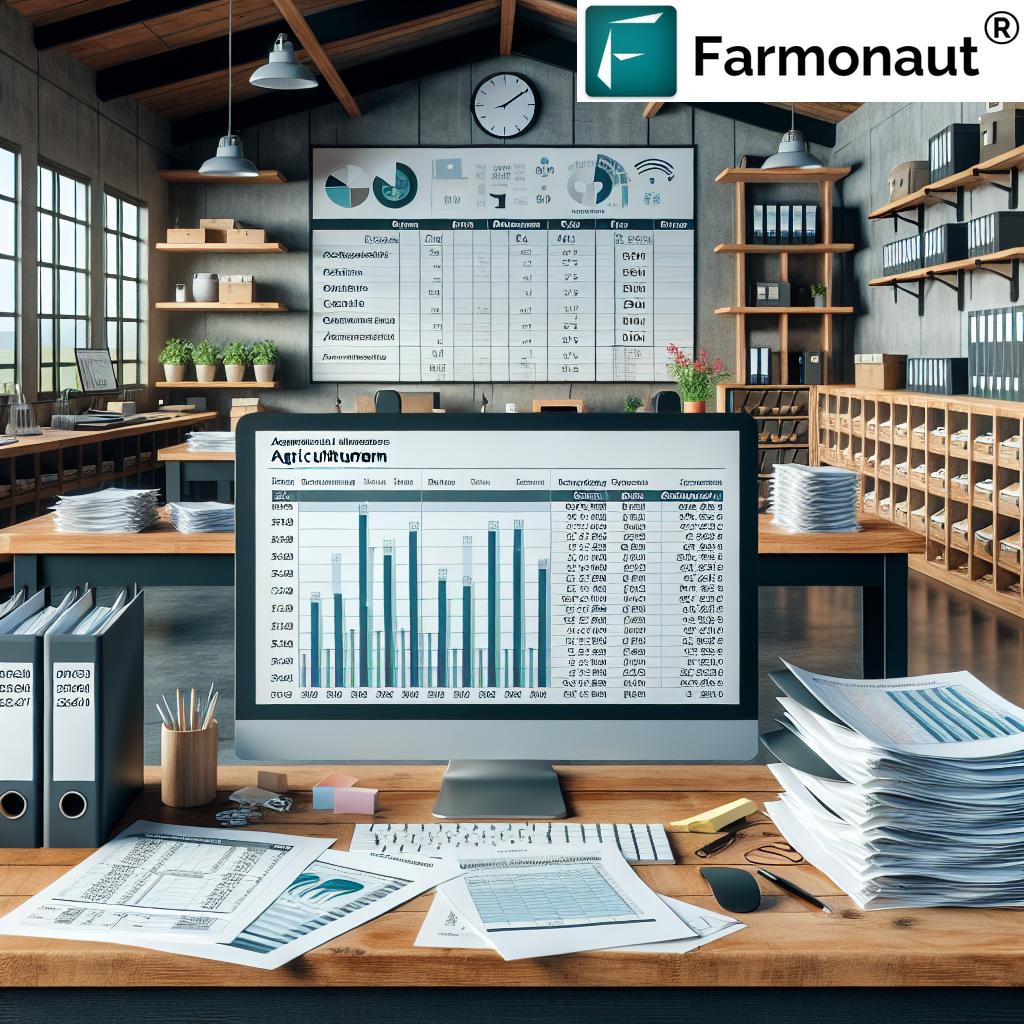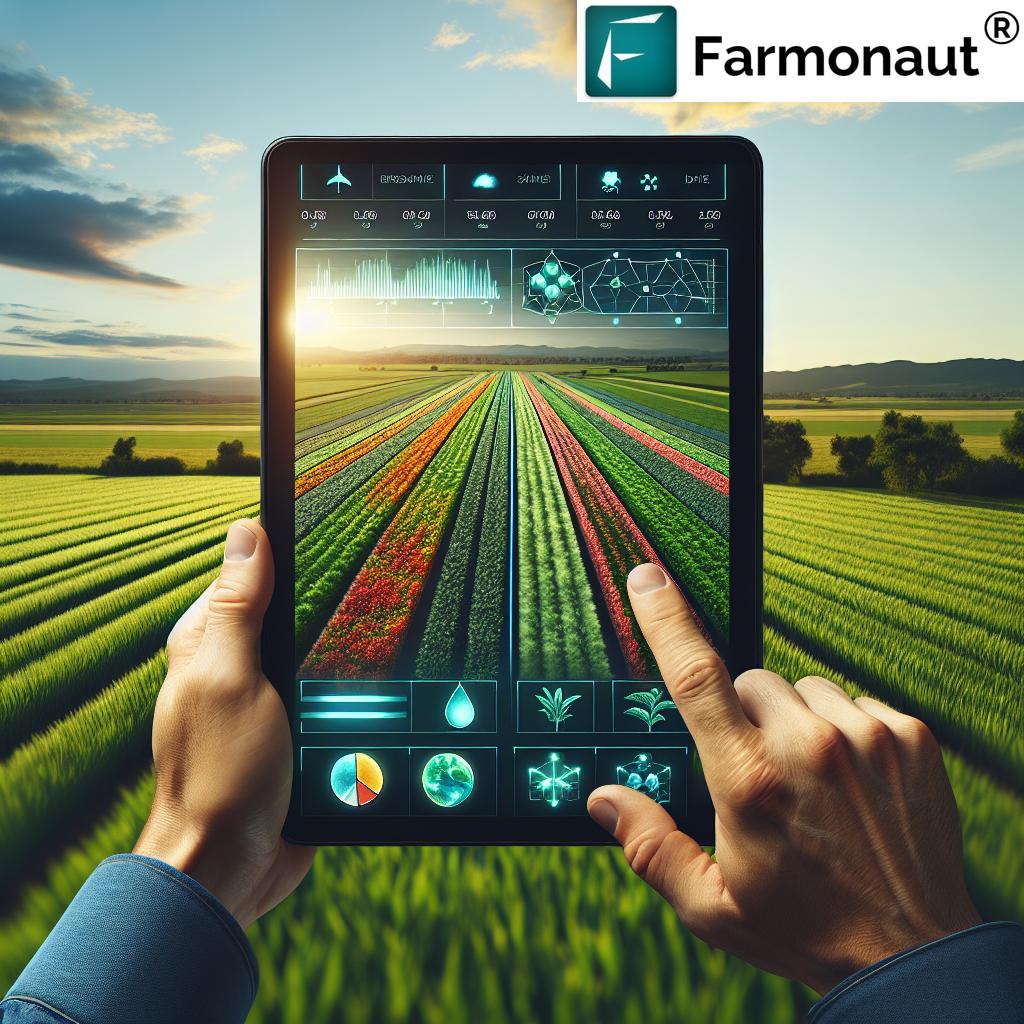Table of Contents
- Introduction: Irrigated Farmland Investment
- Understanding Irrigated Farming Systems
- Top Benefits of Irrigated Row Crop Farmland
- Why Farmland Investment Firms Prefer Irrigated Land
- Technological Advancements Transforming Irrigation & Farming Productivity
- Comparative Table: Irrigated vs. Non-Irrigated Farmland Investments
- Sustainable Practices in Irrigated Agriculture & Water Management
- How We at Farmonaut Support Irrigated Farmland Productivity
- Frequently Asked Questions (FAQ) about Irrigated Farmland Investment
- Conclusion: A Future-Proof Investment Opportunity
Irrigated Farmland Investment: Top Benefits & Yields for 2025 and Beyond
Irrigated farmland investment is gaining considerable attention in 2025, as investors, policymakers, and agricultural stakeholders recognize its critical role in enhancing food security, supporting sustainable farming, and boosting yields. With the global population continuing to rise and climate change introducing increased variability in rainfall patterns, irrigated agriculture has become a cornerstone of resilient and productive food systems. This comprehensive article explores the irrigated farming system, examines the benefits of irrigated row crop farmland, and explains why farmland investment firms are increasingly specializing in this high-potential asset.
Understanding the Irrigated Farming System: The Foundation of Modern Productivity
Irrigated farming systems involve the controlled application of water to crops, supplementing natural rainfall to optimize crop growth and boost productivity. Unlike rainfed agriculture, which depends solely on precipitation, irrigated agriculture enables farmers to manage water use more efficiently, reduce crop stress during drought periods, and cultivate high-value row crops like corn, soybeans, wheat, and cotton.
Key Components of Irrigated Agriculture:
- Controlled Water Delivery: Using irrigation infrastructure, water is applied directly during periods when rainfall is insufficient or unpredictable.
- Technological Integration: Modern systems employ drip, sprinkler, and center-pivot irrigation to ensure precision, minimize waste, and maximize water use efficiency.
- Supplementing Natural Processes: Irrigation supplements, rather than replaces, natural rainfall to maintain crop health even during adverse weather conditions.
- Flexibility: Irrigated farmland allows the cultivation of crops in regions with irregular rainfall patterns, reducing dependence on climate variability.
The importance of irrigated agriculture has never been greater—especially as climate change increases the unpredictability of rainfall, directly impacting crops, yields, and farm income. By investing in irrigation, farmers and firms can unlock higher levels of productivity, better quality produce, and stronger environmental stewardship.
Top Benefits of Irrigated Row Crop Farmland
The benefits of irrigated row crop farmland extend far beyond simply increasing the number of harvests. With a well-managed irrigated farming system, productive gains and risk mitigation combine to create sustainable long-term opportunities for investors and farmers alike.
1. Significantly Enhanced Crop Yields
- Yield Stability: Irrigation ensures crops get the right amount of water at the right time, dramatically reducing the risk of crop failure during droughts. Studies reveal yield increases of up to 70% compared to dryland (rain-fed) farming.
- Higher Output per Hectare: Consistent water delivery results in higher crop volumes per hectare, increasing both quantity and quality of the harvest.
2. Multiple Cropping Cycles per Year
- Year-Round Productivity: Irrigation enables multiple cropping cycles, allowing farmers in areas with irregular rainfall to grow more than one crop per year.
- Diversification Potential: The ability to irrigate supports cultivation of a wider variety of high-value crops, including corn, soybeans, wheat, cotton, and specialty produce, further stabilizing farm incomes.
3. Reduced Risk and Increased Reliability
- Reduced Weather Dependency: Consistent production is achieved year after year, minimizing uncertainties caused by changing weather patterns.
- Investment Security: The lower risk of lost harvests provides a stronger foundation for farmers and investors—with more predictable returns.
4. Improved Soil Health and Sustainability
- Prevention of Salinity & Erosion: Irrigation helps maintain optimal soil moisture, reducing risks of excessive salinity and erosion observed in poorly managed dryland or rainfed systems.
- Soil Structure Maintenance: Well-timed watering sustains beneficial soil organisms and nutrients critical to plant health and yields.
5. Ability to Grow High-Value Crops
- Market Responsiveness: Access to controlled water expands crop selection, allowing farmers to cultivate in-demand, high-value commodities and respond promptly to market signals.
- Economic Advantages: This flexibility enhances both short- and long-term returns for farmland investment firms and landowners.
6. Superior Land Value & Rental Income Potential
- Premium Asset: Irrigated farmland generally commands higher market value, rental rates, and investment security when compared to non-irrigated land—making it a more attractive asset.
- Inflation Hedge: With food demand and commodity prices inflating globally, irrigated farmland offers resilience and sustained asset appreciation.
7. Consistency in Crop Health and Quality
- Timely Watering: Precise irrigation reduces crop stress and supports optimal growth, ensuring more uniform quality across each harvest.
- Higher Marketability: Consistent quality appeals to buyers, processors, and exporters—boosting overall farm revenues.
The benefits of irrigated row crop farmland are increasingly evident, especially as rapid urbanization, climate change, and evolving food preferences drive demand for dependable, high-quality crops.
Why Farmland Investment Firms Specializing in Irrigated Farmland Are Gaining Traction
In 2025, irrigated farmland investment stands out as a strategic, long-term asset class for institutional investors, pension funds, and private equity firms. Several factors explain why the appeal of irrigated farmland investment firms keeps growing:
1. Superior Return on Investment (ROI)
- Irrigated land typically provides 25-40% higher ROI over comparable non-irrigated land, due to greater and more reliable yields.
- Rental incomes and asset appreciation are consistently higher for irrigated farmland, making it a desirable addition to investment portfolios.
2. Resilience Against Market and Climate Risks
- With food security and supply chains under stress due to global disruptions, assets that guarantee consistent production attract considerable attention from long-term investors.
- As water access becomes increasingly regulated and valued, owning irrigated land provides a strategic hedge against production volatility and climate change.
3. Technological Integration
- Firms with access to real-time data analytics, satellite imagery, and precision farming solutions can optimize resource use, minimize waste, and maximize farm profitability.
4. Policy Incentives and Support
- Many governments and international agencies provide infrastructure funding, subsidies, and water rights reforms that increase the viability and security of irrigated agriculture investments.
5. Lower Volatility Compared to Other Asset Classes
- Farmland investments are generally less volatile and more inflation-resistant than stocks or commercial real estate, offering predictable income streams aligned with global food demand growth.
With these advantages, it’s clear why irrigated farmland investment firms specializing in high-yield row crop lands are increasingly sought after by investors seeking resilient, sustainable, and lucrative opportunities in 2025 and beyond.
Technological Advancements Transforming Irrigation & Farming Productivity
The agricultural sector has witnessed rapid technological progression that optimizes every facet of the irrigated farming system. These innovations enhance the efficiency, sustainability, and returns of farmland investments. Below, we outline the most impactful technological trends reshaping the future:
1. Smart Irrigation Systems
- Use of soil moisture sensors and AI-powered smart controllers ensures precision water application—delivering only what the crop needs, when and where it’s needed. This reduces waste and maximizes water use efficiency.
- Integration with weather forecasting models allows for real-time adaptation to changing environmental and rainfall patterns.
- A shift towards renewable-energy-powered irrigation pumps substantially lowers operating costs and environmental footprint.
2. Satellite-Driven Crop Monitoring
- Using multispectral satellite images, farmers get detailed insights about crop health, nutrient deficiencies, soil moisture, and pest infestations—enabling proactive management and minimizing risk.
- Platforms like ours at Farmonaut make such technology widely accessible, affordable, and actionable—from small and medium farms to large-scale investors.
3. Blockchain & Traceability Solutions
- Blockchain technology is providing traceable, transparent records for every step of agricultural production and distribution, ensuring supply chain security and authenticity. Explore our blockchain-based traceability services to enhance food safety and consumer trust.
4. Big Data Analytics & AI-Based Advisory
- Real-time data analytics, machine learning, and AI tools help to forecast yields, analyze risks, and recommend optimal practices from irrigation schedules to input applications.
- Our Jeevn AI Advisory System combines satellite insights and weather data to deliver tailored crop and water management advice for all stakeholders using Farmonaut.
5. Environmental Impact Tracking
- Digital tools monitor carbon footprinting, track resource use, and help operators mitigate the environmental impact of agricultural water usage. Learn about Farmonaut’s carbon footprint monitoring solutions here.
6. Farm Logistics & Resource Management
- Efficient fleet and resource management tools streamline farm operations, reduce downtime, and improve production logistics. Discover Farmonaut’s fleet management platform for agricultural businesses.
These advancements are not only optimizing farm productivity but are also essential to ensuring water resource management is sustainable, scalable, and aligned with global environmental goals.
Comparative Table: Irrigated vs. Non-Irrigated Farmland Investment Benefits
| Investment Aspect | Irrigated Farmland (Estimated 2025 Values) | Non-Irrigated Farmland (Estimated 2025 Values) |
|---|---|---|
| Yield per Hectare (Tons) | 8–12 (row crops: corn, soybeans, wheat, cotton) | 4–7 |
| Water Usage Efficiency | 70–90% (with precision systems) | 30–50% |
| Average ROI (%) | 8–12% annually | 4–6% annually |
| Technology Adoption Rate | High (AI, IoT, satellite, blockchain) | Low–Moderate |
| Risk of Crop Failure | Low (drought-resilient) | High (rainfall dependent) |
| Environmental Benefits | Improved soil health, carbon sequestration, efficient resource use | Vulnerable to erosion, limited by natural rainfall |
| Sustainable Practices | Highly adoptable (precision irrigation, renewables, traceability) | Limited |
As this comparative table shows, irrigated farmland investment isn’t just more productive—it’s also more sustainable, resilient, and technologically advanced, making it a preferred choice for forward-thinking investors in 2025 and beyond.
Sustainable Practices in Irrigated Agriculture & Water Management
Despite the substantial benefits of irrigated farming systems, challenges remain, especially around water management, environmental impact, and resource costs. A sustainable, forward-thinking approach ensures long-term viability, profitability, and stewardship:
1. Efficient Water Use & Conservation
- Precision Irrigation Scheduling: Uses sensor data and analytics to irrigate only when and where crops need it.
- Renewable Energy Integration: Solar-powered pumps significantly reduce operational costs and minimize carbon emissions.
2. Integrated Water Resource Management
- Combining surface and groundwater sources, recycling water, and storing rainfall minimize drought risks and support year-round yields.
3. Soil Health Conservation
- Practices such as controlled traffic farming, rotational cropping, and cover crops, when paired with well-managed irrigation, protect soil structure, prevent salinity build-up, and foster beneficial microorganisms.
4. Environmental Impact Monitoring
- Digital monitoring and reporting of water usage, emissions, and biodiversity supports regulatory compliance and access to green finance.
5. Crop Insurance & Risk Management
- Access to affordable insurance and crop loans reduces downside risk. For streamlined, satellite-powered agricultural loan assessments, see Farmonaut’s Crop Loan & Insurance services.
6. Adopting Regenerative & Climate-Smart Techniques
- Including regenerative practices further improves water retention, reduces greenhouse gases, and increases farm profitability. More on climate-smart adaptation for irrigated farmlands is available from our insights at Farmonaut.
Developer Docs for Farmonaut’s Satellite & Weather API provide quick, robust integration of live farm, crop, and water data.
How We at Farmonaut Empower Irrigated Farmland Investment in 2025
As a leading satellite technology company, we at Farmonaut are committed to transforming irrigated farmland investment by offering affordable, actionable, and scalable solutions. Our advanced platform leverages multispectral satellite imagery, AI, blockchain, and resource management tools to empower farmers, businesses, and investors worldwide.
Key Offerings for the Irrigated Farming Sector
- Satellite-Based Crop Monitoring: Continuous, real-time insights into crop growth, soil health, water efficiency, and stress points, allowing for timely interventions and maximized yields—even in large-scale operations (Large-Scale Farm Management on Farmonaut).
- AI-Driven Farm & Irrigation Advisory: Our Jeevn AI system provides precise, actionable recommendations on irrigation scheduling, water conservation, pest management, and risk reduction for optimal productivity.
- Blockchain-Enabled Traceability: With traceability tools, we facilitate secure, transparent tracking of food products from field to table—enhancing compliance, quality assurance, and consumer trust.
- Real-Time Resource Management: Monitor fleet, machinery, and resource flows with efficiency tools (Fleet Management for Agriculture).
- Environmental Impact Assessment: Carbon emissions data and sustainability monitoring (learn more here) ensure investors and operators meet the highest environmental standards while optimizing land productivity.
Our platform is available via Android, iOS, and web applications, ensuring both individual farmers and institutional investors can access the best technologies in irrigated agriculture from any device, anywhere.
Frequently Asked Questions (FAQ) – Irrigated Farmland Investment
Q1: Why is irrigated farmland investment considered more resilient than non-irrigated (rain-fed) farmland?
Because irrigated farmland is less dependent on unpredictable rainfall patterns, it consistently produces higher and more reliable yields, lowering both crop failure and economic risk—especially as climate change introduces increased rainfall variability in 2025 and the years ahead.
Q2: What are the environmental risks of irrigated agriculture, and how can they be minimized?
Risks include groundwater depletion, excessive salinity, and habitat disruption from inefficient water use. These can be minimized with modern precision irrigation, soil monitoring, renewable-powered pumps, and environmental impact tracking solutions such as those offered on the Farmonaut platform.
Q3: Is irrigated farmland investment only suitable for large-scale investors?
No, while institutional investors often lead large-scale projects, satellite-powered monitoring and smart farming tools (like those from Farmonaut) make it accessible and profitable for smallholders, cooperatives, and individual landowners as well.
Q4: How do technological advancements like AI and satellite monitoring directly improve ROI on irrigated farmland?
They enable real-time crop health assessment, early detection of risks, precision water management, and optimal input application—directly boosting yields, reducing waste, and enhancing profitability. Users of Farmonaut’s platform benefit from increased transparency, traceability, and operational efficiency.
Q5: What kind of crops benefit most from irrigated farmland?
High-value row crops such as corn, soybeans, wheat, cotton, and specialty produce (vegetables, fruits, nuts) achieve the greatest gains from managed irrigation, thanks to improved yield stability and product quality.
Conclusion: Irrigated Farmland Investment Is the Smart Choice for a Resilient, Productive Future
Irrigated farmland investment in 2025 represents the intersection of agricultural innovation, environmental sustainability, and financial opportunity. As global food security concerns intensify amid climate change and rising populations, the advantages of irrigated row crop farmland have never been more apparent. Investors, policymakers, and stakeholders seeking consistent yields, stable returns, and future-proof assets are increasingly turning to advanced irrigation and digital technologies.
With the adoption of precision irrigation, AI, satellite monitoring, and blockchain traceability, irrigated farmland offers superior production, sustainability, and risk management compared to traditional dryland approaches. Importantly, we at Farmonaut are committed to supporting every scale of farming enterprise, empowering them with cost-effective, data-driven solutions to maximize productivity and ensure the long-term viability of their investments.
By embracing the future of irrigated agriculture and leveraging next-generation technology, investors and farmers alike can thrive in an era defined by change, resilience, and innovation.












